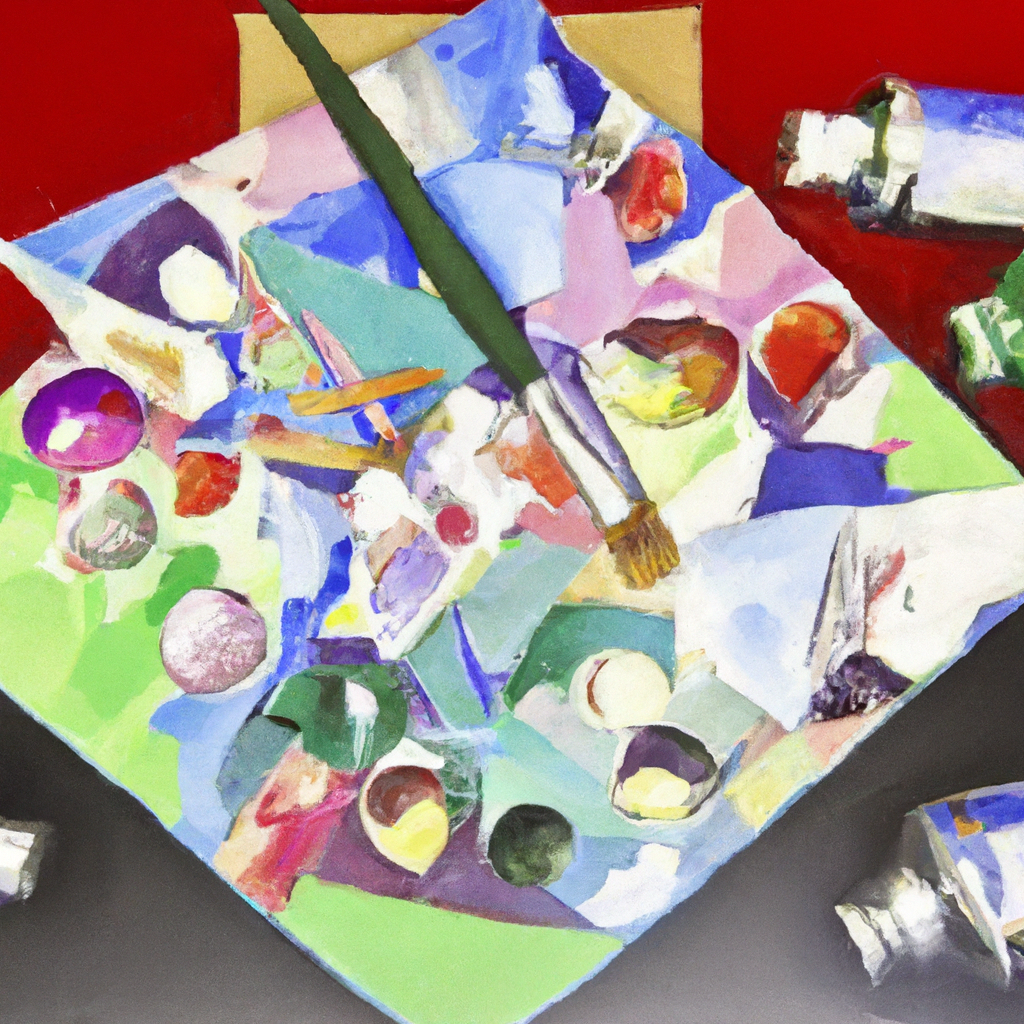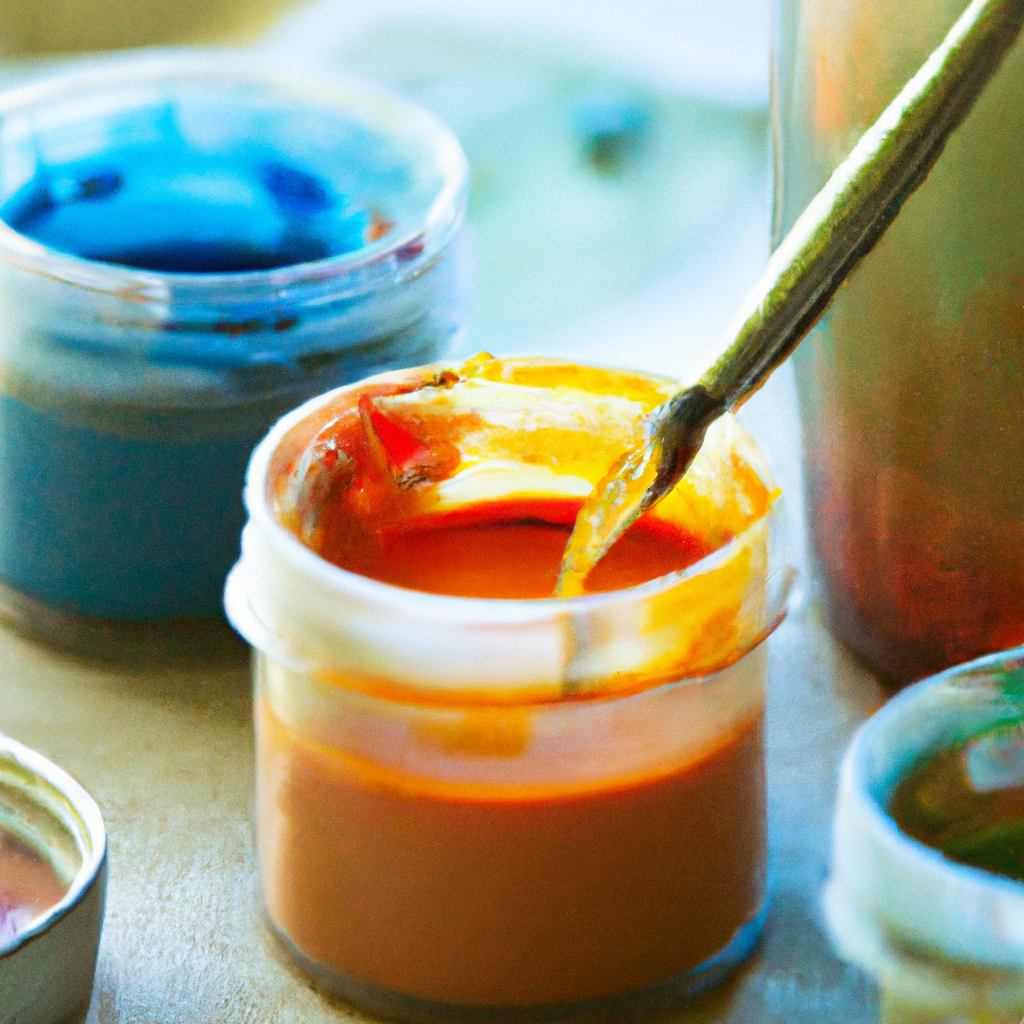Are you a beginner artist wondering if you can mix tempera and acrylic paint together? Look no further for the answer! In this article, we will explore the compatibility of these two popular paint types and discuss the possibilities and limitations of mixing them. Whether you’re looking to experiment with colors or seeking new artistic techniques, we’ve got you covered. So, grab your brushes and join us as we uncover the world of mixing tempera and acrylic paint!

Understanding Acrylic and Tempera Paints
Acrylic paint and tempera paint are two popular choices for artists and hobbyists alike. In order to fully appreciate the unique qualities and potential applications of these paints, it’s important to understand their definitions and common uses.
Definition of Acrylic Paint
Acrylic paint, as the name suggests, is a type of paint that is made with acrylic polymer emulsion. This means that the pigments are suspended in a water-based solution, which dries to form a flexible, water-resistant film. Acrylic paint is known for its quick drying time and versatility, making it a preferred choice for many artists.
Definition of Tempera Paint
Tempera paint, on the other hand, is a type of paint that is made with a mixture of colored pigments, a water-soluble binder (such as egg yolk), and a carrier liquid (usually water). Unlike acrylic paint, tempera paint dries to a matte finish and is not water-resistant. It has been used for centuries, dating back to ancient Egypt, and is known for its vibrant colors and opaque coverage.
Common Uses of Acrylic Paint
Acrylic paint is incredibly versatile and can be used on a wide range of surfaces, including canvas, wood, paper, and even metal. It is commonly used for painting landscapes, portraits, abstract art, and even decorative crafts. Its quick drying time allows for layering and blending, making it a favorite among artists who enjoy experimenting with different techniques.
Common Uses of Tempera Paint
Tempera paint has a long history of usage in art education and is often used by children due to its non-toxic nature. It is commonly used in schools for various art projects and for creating illustrations. Its opaque nature makes it ideal for creating bold and vibrant artwork, and it can be applied on surfaces such as paper, cardboard, and wood.
Characteristic Differences between Acrylic and Tempera Paints
While both acrylic and tempera paints serve their own unique purposes, they differ in terms of texture, drying time, and color vibrancy.
Differences in Texture
Acrylic paint typically has a smooth and creamy texture, allowing for easy application and blending. On the other hand, tempera paint has a thicker consistency and can sometimes have a grainy texture, especially when using dry pigments mixed with the binder. This difference in texture can impact the overall appearance and feel of the finished artwork.
Differences in Drying Time
One significant difference between these two types of paint is their drying time. Acrylic paint dries relatively quickly, often within minutes or hours, depending on the thickness of the application. This allows artists to work efficiently and build layers of paint. Tempera paint, however, takes longer to dry, usually requiring several hours or even days to fully set. This slower drying time can be advantageous for artists who prefer a more deliberate working process.
Differences in Color Vibrancy
Acrylic paint is known for its vibrant, intense colors that remain true and consistent even after drying. It has a high pigment load, resulting in strong color saturation and a wide range of hues. On the other hand, tempera paint tends to have a more subtle, matte finish. While it can still produce rich and vibrant colors, they may appear slightly muted compared to acrylic paint.
Benefits of using Acrylic Paint
Acrylic paint offers several advantages that make it a popular choice among artists:
Versatility of Acrylic Paint
One of the greatest benefits of using acrylic paint is its versatility. It can be used on a wide range of surfaces, including canvas, wood, metal, and even fabric. It adheres well to these surfaces and can withstand a variety of environmental conditions. This versatility allows artists to explore different mediums and experiment with various techniques to achieve their desired results.
Dry Time of Acrylic Paint
The quick drying time of acrylic paint is often highly valued by artists. Unlike oil paints that can take days or even weeks to fully dry, acrylic paint dries within minutes or hours, depending on the thickness of the application. This fast drying time enables artists to work more efficiently, as they can apply additional layers or make adjustments to their artwork without waiting for extended periods.
Acrylic Paint Longevity
Acrylic paint is known for its durability and longevity. Once dry, it forms a water-resistant and flexible film that can withstand the test of time. This makes it an excellent choice for artwork that may be exposed to outdoor elements or require regular cleaning. The long lifespan of acrylic paintings allows for their preservation and enjoyment for many years to come.
Benefits of using Tempera Paint
While acrylic paint has its merits, tempera paint also offers its own unique advantages:
Ease of Use of Tempera Paint
Tempera paint has long been favored for its ease of use, especially in educational settings. It is non-toxic, making it safe for children to handle and is easily washable from hands and clothing. Its water-based nature allows for easy clean-up, making it a convenient choice for classrooms or home studios where mess prevention is important. Additionally, tempera paint has a low odor, making it an appealing option for artists who are sensitive to strong smells.
Drying Time of Tempera Paint
The slower drying time of tempera paint can be advantageous in certain situations. Unlike acrylic paint, which dries quickly, tempera paint allows for more time to work on a piece without rushing. This can be particularly beneficial for artists who prefer to take their time and work in layers or make adjustments along the way. The extended drying time also enables artists to create subtle blends and gradients in their artwork.
Nature of Tempera Paint
Tempera paint has a distinct texture and finish that is loved by many artists. It often dries to a matte or eggshell-like finish, which can create an attractive effect on the artwork. This finish produces a velvety texture that adds depth and dimension to the painting. Additionally, the opaque coverage of tempera paint allows artists to achieve bold and solid color blocks that can be difficult to achieve with other types of paint.

The Possibility of Mixing Acrylic and Tempera Paints
The question of whether it is possible to mix acrylic and tempera paints is a common one among artists seeking to explore new possibilities. While it is technically possible to mix these two paints, there are certain factors and considerations to keep in mind.
Factors Influencing the Mixing of Acrylic and Tempera Paints
The compatibility of acrylic and tempera paints depends on the specific brands and formulations of the paints. Some acrylic paints are formulated to be more compatible with other mediums, including tempera paint, while others may not mix well. It is advisable to read the paint labels or consult the manufacturer’s recommendations to ensure compatibility before attempting to mix them.
Understanding the Concept of Cross-Mixing Paints
Cross-mixing refers to combining different types of paints to achieve unique effects and properties. It can be a way for artists to experiment and create artwork that incorporates the best qualities of each paint. When trying to mix acrylic and tempera paints, it is important to be aware that certain characteristics, such as drying time and texture, may be affected.
Effects of Mixing Acrylic and Tempera Paints
When mixing acrylic and tempera paints, several factors can influence the outcome of the artwork.
Impact on Drying Time
When acrylic paint and tempera paint are mixed, the drying time can be the most noticeable effect. Acrylic paint generally dries much faster than tempera paint. Therefore, the resulting mix may have a compromised drying time, taking longer to dry compared to pure acrylic paint but still faster than pure tempera paint. This extended drying time can affect the artist’s working process and may require additional patience when creating artworks.
Impact on Color Blending
When mixing acrylic and tempera paints, the resulting color may not be as vibrant or consistent as using either paint on its own. Acrylic paint is known for its strong and vibrant colors, while tempera paint tends to have a more subtle and matte appearance. The mixture of these paints may result in a compromise, with colors appearing less intense or diluted. Artists looking for specific color effects may need to experiment with different ratios or layering techniques to achieve their desired results.
Impact on Texture
Texture can also be impacted when mixing acrylic and tempera paints. As previously discussed, acrylic paint has a smooth and creamy texture, while tempera paint can have a thicker and grainier consistency. When combined, the resulting texture may vary, depending on the ratios and specific paints used. Artists seeking to maintain a specific texture in their artwork may need to experiment with mixing techniques to achieve the desired outcome.

Practical Applications of Mixing Acrylic and Tempera Paints
While there are potential challenges when mixing acrylic and tempera paints, there are also creative opportunities worth exploring.
Artistic Techniques Made Possible
By combining the unique characteristics of acrylic and tempera paints, artists can create innovative and dynamic effects. Mixing these two paints can allow for interesting texture variations and the layering of colors with different drying times. Artists can experiment with techniques such as glazing, impasto, and sgraffito to add depth and dimension to their artwork.
Mixed-Media Artwork
Mixing acrylic and tempera paints can open up a world of possibilities for mixed-media artwork. Artists can combine paints with other materials, such as collage elements, ink, or pastels, to create multimedia artworks. This combination of different mediums can result in visually striking and texturally diverse artworks.
Experimental Art
The exploration of mixing acrylic and tempera paints can be regarded as an experimental artistic practice. Artists can use this technique to push the boundaries of traditional painting methods and challenge conventional notions of materials and techniques. The unpredictable nature of the paint mixture can lead to unexpected and exciting results, making each artwork truly unique.
Disadvantages of Mixing Acrylic and Tempera Paints
While there are potential benefits and artistic possibilities, there are also drawbacks to consider when mixing these two paints.
Potential Issues During Drying Process
As mentioned earlier, the mix of acrylic and tempera paints can result in a compromised drying time. This can be frustrating for artists who prefer a faster drying process or who need to work quickly. Additionally, the extended drying time may increase the risk of accidental smudging or blending of colors, especially during the creation of multiple layers.
Issues with Stability and Longevity
Mixing acrylic and tempera paints can impact the overall stability and longevity of the artwork. Acrylic paint, when used alone, is known for its durability and water resistance once dry. However, the addition of tempera paint may compromise these qualities. The combined paint may be more prone to cracking or peeling over time, potentially affecting the integrity of the artwork.
Problems with Color Clarity and Intensity
When mixing acrylic and tempera paints, there can be challenges in achieving consistent color clarity and intensity. As mentioned earlier, the characteristics of these two paints are different, with acrylic paint offering vibrant and intense colors, while tempera paint has a more subtle and matte appearance. The combination of these paints can result in a compromise, with the final colors appearing less vibrant or diluted.
Expert Opinions on Mixing Acrylic and Tempera Paints
In the art world, there are artists who actively mix different types of paints to create their desired effects.
Famous Artists who Mix Paints
Some famous artists have recognized the potential of mixing acrylic and tempera paints. For example, mixed-media artist Kandace Harrington often combines acrylic and tempera paints in her artwork, creating vibrant and layered compositions. Similarly, artist Anne Siems often incorporates tempera paints into her acrylic paintings, resulting in textured and ethereal artworks.
Scientific Explanation on Acrylic and Tempera Paint Mixing
From a scientific perspective, the compatibility of acrylic and tempera paints can be influenced by the chemical composition and characteristics of the paints. Each paint has its own unique binder and pigments, which may interact and affect the drying time, adhesion, and color properties. Understanding the chemical makeup of the paints can provide further insights into their compatibility and the potential effects of mixing.
Tips for Successfully Mixing Acrylic and Tempera Paint
If you decide to explore the world of mixing acrylic and tempera paints, here are some tips to consider for a successful outcome:
Proper Preparatory Steps
Before mixing the paints, ensure that the surfaces and materials are clean and free from any contaminants. It is also advisable to experiment on a small test surface before working on a larger piece to gauge the compatibility and effects of the paint mixture.
Ideal Mixing Ratios
Experiment with different ratios of acrylic and tempera paints to achieve the desired effects. Start with small amounts of each paint, gradually adding more to adjust the consistency and color. Keep in mind that the final result may differ based on the specific brands and formulations of the paints used.
Correct Application Methods
Consider the desired effect and adjust the application methods accordingly. Experiment with brushes, sponges, or palette knives to create different textures and apply the mixed paint using different techniques such as layering, stippling, or splattering.
Post-Painting Care for Mixed Medium Artwork
Once the artwork is complete, ensure proper care to maintain its longevity. This includes protecting it from direct sunlight, extreme temperatures, and high humidity to minimize potential damage to the paint surface. If necessary, consult a professional conservator or art restorer for specific recommendations on preserving mixed medium artworks.
In conclusion, the possibility of mixing acrylic and tempera paints offers both opportunities and challenges for artists. By understanding the characteristics of these paints, the effects of mixing, and proper techniques, artists can experiment and create unique artworks that showcase the best qualities of both mediums. Whether it’s exploring new techniques or creating mixed-media masterpieces, mixing acrylic and tempera paints can add excitement and innovation to artistic endeavors.



